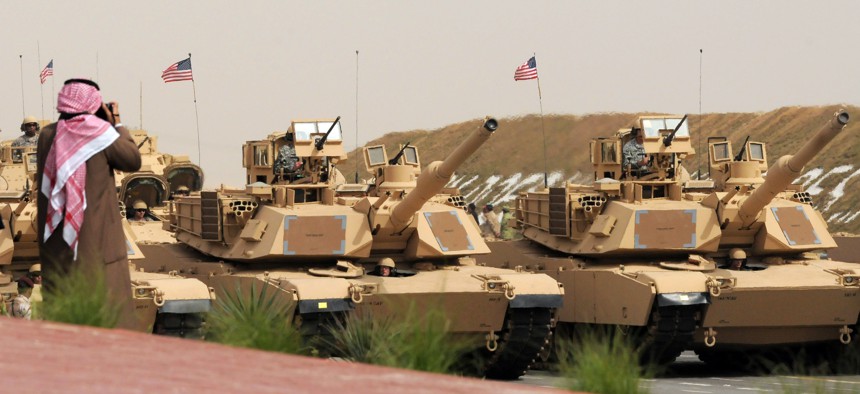
U.S. Army heavy battle tanks are seen during a military parade commemorating the 20th anniversary of the liberation of Kuwait from the 1990 Iraqi invasion in Subiya, Kuwait, Feb. 26, 2011. Gustavo Ferrari/AP
What the US Gives Its Mideast Partners Isn’t Always What They Need
Instead of 'prestige weapons' worth billions, look at UAE’s special operators or Palestine’s security forces.
As President Obama heads to Saudi Arabia later this week for a summit with Gulf Cooperation Council leaders, the American public and policymakers are generally united in their desire to avoid another large-scale investment of U.S. forces in the region. Instead, as President Obama recently made clear in his interview with The Atlantic’s Jeffrey Goldberg, the preferred approach is to ask our regional partners to take a greater leadership role in confronting the challenges of state failure and terrorism. But if that is truly the objective, there continues to be a major mismatch between the security assistance the United States provides and what its partners would actually need to step up.
Too often, U.S. security assistance to its Middle Eastern partners is imbalanced toward big-ticket military hardware such as multi-billion-dollar advanced fighter jet deals. These sales do not need to stop. They are valuable for American industry and they deepen U.S. relations with regional partners. They are oftentimes what a regional partner wants for their own security and for global and regional prestige. But this type of assistance does not address the complex challenge caused by increasingly more effective and dangerous asymmetric threats such as ISIS, al-Qaeda and its affiliates, or Iran’s Islamic Revolutionary Guard Corps (IRGC) and its proxies.
Look at U.S. military aid to the Gulf states: between 2008 and 2011, there was an eight-fold increase in the number of export agreements concerning prestigious conventional weapons. And at last May’s Camp David Summit, the U.S. responded to its Gulf partners’ fear about the spread of Iranian influence and the looming nuclear deal by promising to allow an estimated $15 billion in new arms sales.
By contrast, the IRGC is accomplishing its region-wide agenda through sectarian surrogates for far less money—roughly $2 billion per year—and with greater strategic return to its core interests. Iran has employed a longer-term approach built on transforming local politics and shaping state institutions to its favor in Lebanon, Iraq, Syria, and, to a lesser extent, Yemen. This is an unconventional warfare strategy that U.S. partners have not been able to address by conventional means. Thus, despite the GCC’s conventional and irregular warfare advantage over Iran, they are unable to collectively exercise their superior military edge.
Related: Start Preparing for the Collapse of the Saudi Kingdom
Read more: In Increasingly Turbulent Middle East, US-Saudi Partnership Is Indispensable
See also: Swooning for Saudi Arabia
Worryingly, a heavy-handed conventional response to these threats by U.S. partners can lead to even greater radicalism and support for ideological extremist groups. But if all you have is a hammer, everything starts to look like a nail.
Saudi Arabia has engaged in a mainly conventional counter-terrorism air campaign in Yemen that has led to dramatic loss of civilian life, suffering, and extensive destruction of the country’s infrastructure. Egypt responded to a long-running ISIS insurgency in the Sinai with too much conventional military power, to deleterious effect.
However, there are positive templates for U.S. security assistance and collaboration with its Middle Eastern partners in counterterrorism. Over the last 10 years, the United States has helped to dramatically improve the Palestinian Security Forces. With an investment of less than $1 billion since 2008, the United States has significantly improved Palestinian capacity while also fostering increased coordination between Israeli and Palestinian security forces. Even with today’s terrible political environment, the last six months of violence have seen far fewer casualties than during the Second Intifada of the early 2000s, when Palestinian security mechanisms were much weaker. This success is due in part to to the fact that all sides recognize that a future Palestinian state will be demilitarized and will have no high-end weaponry. So the automatic instinct to focus on such items is eliminated.
There also other positive examples in the Middle East. The United Arab Emirates (UAE) has developed the region’s most effective special operations forces, which have deployed to conflicts in Libya and Afghanistan. UAE SOF has been the GCC’s most effective fighting force in Yemen, where they are leading the unconventional warfare effort on the ground to stabilize the southern part of the country. The UAE is also one of the few Middle Eastern countries who have been able to deploy their conventional capabilities in a way that has meaningfully assisted the United States.
In Jordan, the United States has invested heavily in a border security system that has helped the Jordanians manage the flow of extremists across the Syrian border. This has helped Jordanians ensure that aid that goes into Syria gets to more moderate groups such as the Southern Front in Southern Syria, not extremist groups such as Al Qaeda’s Syrian affiliate Jabhat al-Nusra.
If one of President Obama’s aims this week is to ask our partners to be out front on the counterterrorism fight, we need to help them build the tools they need to succeed. This means thinking strategically about the proper balance between military hardware, policing, training and civil society capacity-building assistance. Following this approach will require discipline from the United States and from our partners, who must kick the bad habits of focusing too heavily on cool toys that do not solve underlying problems.




